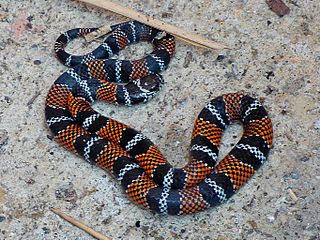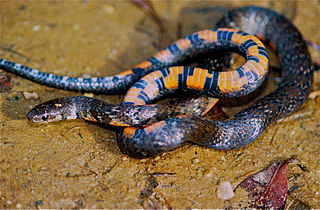
The royal ground snake is a species of snake in the family Colubridae. The species is endemic to northern South America.

Erythrolamprus cobella, commonly known as the mangrove snake, is a species of small semi-aquatic snake, which is endemic to South America.
Erythrolamprus ocellatus, commonly known as the Tobago false coral snake, red snake, or doctor snake is a species of colubrid snake, which is endemic to the island of Tobago.

Erythrolamprus bizona, commonly known as the double-banded false coral snake, is a species of colubrid snake, which is found in northern South America and Central America.

Erythrolamprus aesculapii, also known commonly as the Aesculapian false coral snake, the South American false coral snake, and in Portuguese as bacorá, or falsa-coral, is a species of mildly venomous snake in the family Colubridae. The species is endemic to South America.
False coral may refer to many species of snakes, including:

James Ray Dixon was professor emeritus and curator emeritus of amphibians and reptiles at the Texas Cooperative Wildlife Collection at Texas A&M University. He lived in El Campo, Texas, throughout most of his childhood. He published prolifically on the subject of herpetology in his distinguished career, authoring and co-authoring several books, book chapters, and numerous peer reviewed notes and articles, describing two new genera, and many new species, earning him a reputation as one of the most prominent herpetologists of his generation. His main research focus was morphology based systematics of amphibians and reptiles worldwide with emphasis on Texas, US, Mexico, Central America, and South America, although bibliographies, conservation, ecology, life history and zoogeography have all been the subjects of his extensive publications.
Aspidoras rochai, commonly known as the loach catfish, is a tropical freshwater fish belonging to the Corydoradinae sub-family of the family Callichthyidae. It originates in inland waters in South America, and is found in coastal rivers in Ceará, Brazil.

Erythrolamprus is a genus of colubrid snakes native to Central America, the Caribbean, and South America. They include the false coral snakes, which appear to be coral snake mimics.
Dixon's ground snake is a species of snake in the family Colubridae. The species is endemic to Southeastern Brazil.
Lacépède's ground snake is a species of snake in the Colubridae family. It is endemic to Caribbean island of Martinique. Little is known of it scientifically, and few photographs exist.
Erythrolamprus ornatus, also known commonly as the ornate ground snake and the Saint Lucia racer, is a species of snake in the family Colubridae. The species is native to the eastern Caribbean. It is the rarest snake on earth with fewer than 20 left in the wild.
The Barbados racer, also commonly known as the tan ground snake, was a species of colubrid snake that was endemic to Barbados. It is now extinct.

Julia's ground snake is a species of snake in the subfamily Dipsadinae of the family Colubridae. The species is found in the Caribbean, on the Lesser Antilles islands of Dominica and Guadeloupe. There are three subspecies.
Shaw's dark ground snake, also known commonly as Shaw's black-backed snake, and in Spanish as candelilla, guarda caminos, and reinita cazadora, is a species of snake in the family Colubridae. The species is native to northern South America.

The military ground snake is a species of snake in the family Colubridae, which is endemic to South America.

Erythrolamprus epinephalus, the Fire-bellied snake, is a species of snake in the Colubridae family. It is found in Costa Rica, Panama, Colombia, Venezuela, Ecuador, and Peru. The snake, which was described by Edward Drinker Cope in 1862, is notable for its apparent immunity to the toxic skin of the golden poison dart frog, which it preys upon.

Erythrolamprus breviceps, the short ground snake, is a species of snake in the family Colubridae. The species is found in Suriname, Brazil, Ecuador, Colombia, Bolivia, Peru, French Guiana, and Guyana.

Erythrolamprus typhlus, the blind ground snake or velvet ground snake, is a species of South American snake in the family Colubridae. It is found in Colombia, Venezuela, Guyana, Suriname, French Guiana, Brazil, Peru, Ecuador, Paraguay, and Bolivia.










